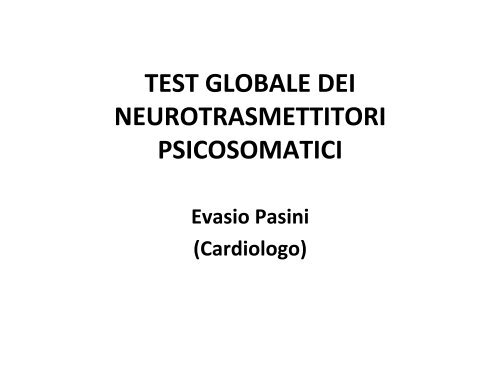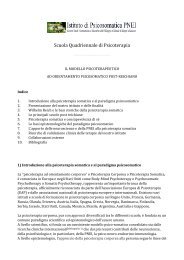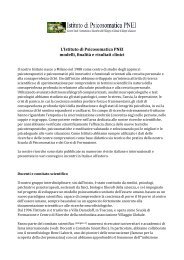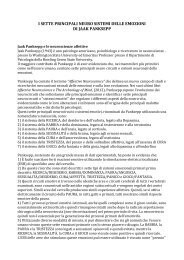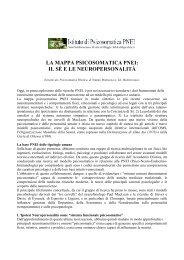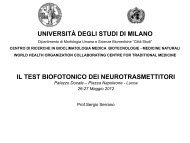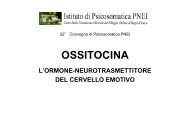test globale dei neurotrasmettitori psicosomatici - Psicosomatica PNEI
test globale dei neurotrasmettitori psicosomatici - Psicosomatica PNEI
test globale dei neurotrasmettitori psicosomatici - Psicosomatica PNEI
You also want an ePaper? Increase the reach of your titles
YUMPU automatically turns print PDFs into web optimized ePapers that Google loves.
TEST GLOBALE DEI<br />
NEUROTRASMETTITORI<br />
PSICOSOMATICI<br />
Evasio Pasini<br />
(Cardiologo)
COSA C’ENTRA LA<br />
CARDIOLOGIA CON<br />
LA <strong>PNEI</strong>?
The Neuro, Endo, and Immune systems<br />
are in constant conversaFon<br />
and regulate global metabolism<br />
…<br />
N E<br />
and cell life<br />
?<br />
I<br />
3<br />
!<br />
3
The Neuro-‐Endo-‐Immune (NEI) System is<br />
Represented By:<br />
NeurotransmiNers<br />
Cytokines<br />
Hormones
Understanding the<br />
Cross talk between<br />
the 3 key systems<br />
The NEI System<br />
5
Regional SNS Control of Immunity Consists of<br />
Two Components<br />
1. Neuronal component (Sympathe=c Nerves)<br />
– Through innerva=on of immune organs and release of<br />
NE and other neurotransmiBers or pep=des<br />
2. Hormonal component (HPA-‐axis)<br />
– Regulates immunity (inflamma=on) systemically<br />
– Through release of Epi and cor=sol from the adrenal<br />
glands
The Brain Monitors and Regulates Immune<br />
Responses (A)<br />
• Signaling between the<br />
immune system and the<br />
CNS is mediated by:<br />
– Sympathe=c nervous<br />
system (SNS)<br />
– Parasympathic<br />
nervous system (PNS)<br />
• Vagus nerve<br />
Sternberg, E.M. (2006). Neural regulation of innate immunity: A<br />
coordinated nonspecific host response to pathogens. Nature<br />
Reviews, 6, 318-328.
• Inflamma&on<br />
influences Hormones<br />
• Hormones influences<br />
Inflamma&on<br />
Inflammatory triggers:<br />
• Bacteria<br />
• Parasites<br />
• Viruses<br />
• Food proteins<br />
• Environmental toxins<br />
• Psychosocial stress<br />
8<br />
Sternberg, E.M. (2006). Nature Reviews 6:318-‐328.
Neuropep=des in Inflamma=on<br />
• S=mulatory<br />
– Cor=cotrophin releasing hormone (CRH)<br />
– Neuropep=de Y (NPY)<br />
– Substance P<br />
– Calcitonin gene-‐related pep=de (CGRP)<br />
• Inhibitory<br />
– Vasoac=ve intes=nal pep=de (VIP)<br />
– Opiods (methionine-‐eukephaline)<br />
– α-‐Melanocyte s=mulatory hormone (α-‐MSH)
ENDOCRINE PLAYERS IN INFLAMMATION<br />
• Adrenal Hormones (cor=costeroids)<br />
• Sex Hormones (Estrogens, Progesterone)<br />
• Thyroid Hormones
Excitotoxicity<br />
& apoptosis<br />
InflammaFon can affect<br />
neurotransmiNer levels & behavior<br />
↑ glutamate<br />
↓ serotonin<br />
↑ quinolinic<br />
acid 1<br />
1 Halperin & Heyes, 1992
Do these symptoms look familiar?<br />
Cognitive Issues<br />
Brain Fog<br />
Anxiety Weight Gain<br />
Insomnia<br />
Poor Psychomotor Performance<br />
Depression<br />
Irritability<br />
Sensory Hyperarousal<br />
Fatigue<br />
Chronic inflamma&on can<br />
result in these and other<br />
neuro/endo/metabolic<br />
symptoms<br />
12<br />
12
ESEMPIO (Intake Alimentare) RETE SEGNALI TRA ORGANI<br />
Cervello-‐IntesFno-‐Tessuto Adiposo-‐Muscolo-‐Pancreas<br />
BRAIN<br />
AgRP Catecholam.<br />
MCH Cor&sol<br />
NPY Neurotrasm.<br />
Α-‐MSH Releas. Factors<br />
Orexin CART<br />
Neurotensin<br />
GastrointesFne Adipose Tissue Muscle Pancreas<br />
Gherlin GLP1 Adiponec&n AAs<br />
Bombesin Obesta&n Lep&n Amylin<br />
CCK Resis&n Glucagon<br />
GIP TNF-‐α Insulin<br />
PYY Polipe&des
COME GLI ORNOMI E LE<br />
CITOCHINE INFLUENZANO<br />
IL METABOLISMO/FUNZIONE<br />
GENERALE<br />
E MUSCOLARE?
Catabolic Stimuli<br />
• Cortisol<br />
• Catecholamines<br />
• Glucagone<br />
• Cytokines<br />
• Others<br />
Protein syntesis<br />
NORMAL<br />
MUSCLE<br />
Protein Breakdown<br />
AA AA Energy<br />
Cellular<br />
Protein<br />
Syntesis<br />
Blood<br />
pool<br />
Of AA<br />
Cellular Energy<br />
Production<br />
Anabolic S&muli<br />
• Insulin<br />
• IGF-‐alfa<br />
• Others<br />
AA Release<br />
Glucose<br />
(via gluconeogenesis)<br />
16
Ipercatabolic Sindrom Insulin Resistence<br />
Catabolic Stimuli<br />
• Cortisol<br />
• Catecholamines<br />
• Glucagone<br />
• Cytokines<br />
• Others<br />
Protein syntesis<br />
Cellular<br />
Protein<br />
Syntesis<br />
MUSCLE<br />
Protein Breakdown<br />
Blood<br />
pool<br />
Of AA<br />
Cellular Energy<br />
Production<br />
AA Release<br />
Anabolic Stimuli<br />
• Insulin<br />
• IGF<br />
• Others<br />
Glucose<br />
(via<br />
gluconeogenesis)<br />
17
EffeBo NEI sull’ANZIANO<br />
Evidenze Clinico/<br />
Sperimentali
Muscle<br />
Young Control (water)<br />
Elder Control. Large space<br />
between myofibres are seen<br />
commonly (arrows).<br />
19
Skeletal Muscle:<br />
Morphometric Pameters<br />
Groups Treatment Sarcomere<br />
1 Young<br />
2 Elder<br />
Statistic<br />
P
10<br />
9<br />
8<br />
7<br />
6<br />
5<br />
4<br />
3<br />
2<br />
1<br />
0<br />
DNA Mitocondriale Totale<br />
Giovani Anziani<br />
21
25<br />
20<br />
15<br />
10<br />
5<br />
0<br />
PGC-‐1Alfa<br />
(gene che regola la mitocondriogenesi)<br />
Giovani Anziani<br />
22
Sirius Red: valutazione fibrosi muscolo scheletrico<br />
Luce polarizzata<br />
Luce polarizzata<br />
Anziano controllo 20x<br />
Luce polarizzata<br />
(fibre rosse = fibrosi))) oltre alla<br />
fibrosi si osserva una forte<br />
disorganizzazione delle fibre collagene.<br />
Giovane controllo 20x<br />
Luce polarizzata<br />
(fibre gialle = collagene costitutivo)<br />
Non si osserva fibrosi disorganizzazione<br />
del collagene<br />
23
EffeBo NEI sullo<br />
Scompenso Cardiaco<br />
Evidenze<br />
Clinico/Sperimentali
Is Nutri&onal Intake Adequate<br />
in CHF Pa&ents?<br />
Aquilani, Pasini et al: J Am Coll Cardiol 42(7) 1218-‐1223-‐2003<br />
• 57 pz non obesi anziani (NYHA II-‐III) + 49 controlli<br />
• BMI>25<br />
• Valuta= per 7 gg:<br />
– Introduzione quan=/qualita=va di cibo<br />
– Res=ng e Total Energy Expenditure (REE e TEE)<br />
mediante calorimetria indireBa<br />
– Bilancio azotato (valutazione demolizione AA)<br />
– Quadro ormonale (bilancia ana/catabolica)<br />
25
Is Nutri&onal Intake Adequate in CHF Pa&ents?<br />
Consumo EnergeFco<br />
Figure 1<br />
kcal/m 2<br />
kcal/m 2<br />
1000<br />
750<br />
500<br />
250<br />
0<br />
2000<br />
1000<br />
0<br />
* p
Is Nutri&onal Intake Adequate in CHF Pa&ents?<br />
Bilancio Calorico<br />
Figure 2<br />
kcal/day<br />
300<br />
200<br />
100<br />
0<br />
-100<br />
-200<br />
-300<br />
* p
Is Nutri&onal Intake Adequate in CHF Pa&ents?<br />
Bilancio Azotato<br />
Figure 3<br />
g/day<br />
3<br />
2<br />
1<br />
0<br />
-1<br />
-2<br />
-3<br />
* p
Is Nutri&onal Intake Adequate in CHF Pa&ents?<br />
Quadro Ormonale<br />
Cor&solo (nmol/L)<br />
Controlli = 308+94 CHF=631* +182<br />
Insulina (uUL/ml)<br />
Controlli = 13.2+7.6 CHF=10.7+4.0<br />
Cor&solo/Insulina<br />
Controlli = 23.3+12 CHF= 59.1*+25<br />
*p
Increased Skeletal Muscle AA Release with Light Exercise in<br />
Decondi&oned Pa&ents with Heart Failure<br />
(Aquilani, Pasini et al: J Am Coll Cardiol 2005 )<br />
• We evaluate the effects of light work (20 WaBs by<br />
cycleBe) on the net muscle release of AA<br />
• We studied chronically stable untrained<br />
normonourished CHF pa=ents (NYHA II/III) +<br />
controls<br />
• Net AAs uptake/release was calculated as A-‐V<br />
difference x leg flow (by catheters into and<br />
Femoral Artery and Vein)<br />
• Blood AA concentra=on were measured by HPLC
NET AMINOACID UPTAKE AND RELEASE<br />
Muscle amino<br />
acid net uptake<br />
and/or release at<br />
rest and during<br />
light exercise<br />
(20W) in controls<br />
(open bars) and<br />
chronic heart<br />
failure (CHF)<br />
patients (solid<br />
Bars)
Increased Skelatal Muscle AA Release with Light Exercise in<br />
DecondiFoned PaFents with Heart Failure<br />
(J Am Coll Cardiol 2005 )<br />
Cor&sol (nmol/L)<br />
Control = 297+78 CHF=703* +151<br />
Insulin (uUL/ml)<br />
Control = 12.7+5.5 CHF=11.3+6.0<br />
Cor&sol/Insulin<br />
Control = 23.4+9 CHF= 63.2*+28<br />
*p
p-mTor<br />
m-Tor<br />
Cont. Cont. AAs<br />
33
Intracellular metabolism. The role of signalling via the mTor pathway and other<br />
routes<br />
(Fla&, Pasini et al: Am J Cardiol 2008)<br />
TNFα<br />
p38MAPK<br />
IKK<br />
MMPs<br />
Apoptosis<br />
ROS<br />
SOCS<br />
Insulin<br />
IRS1-2<br />
PI3K<br />
AKT<br />
mTor<br />
4EBP1<br />
Protein Synthesis<br />
Glucose<br />
GLUT4<br />
GLUT4<br />
Glucos e Upta ke<br />
p70S6K<br />
Unknown<br />
mediator<br />
Amino acids<br />
S6<br />
AA<br />
Rheb TSC1/2<br />
Unknown<br />
mediator<br />
eNOS/NO<br />
PGC1-α<br />
Number/Function<br />
of Mitochondria<br />
ATP<br />
Stimulation<br />
Inhibition
Health Issues can be pinpointed<br />
by assessing NEI imbalances ???<br />
• Yes. But is a New Approach…<br />
How???<br />
• Measuring:<br />
– Anabolic/Catabolic Circula=ng Molecules<br />
– Metabolic/Func=onal effects on body organs<br />
• IntegraFng data


